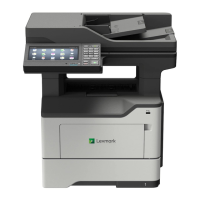Notes:
• View the printer IP address on the home screen. The IP address appears as four sets of numbers
separated by periods, such as 123.123.123.123.
• If you are using a proxy server, then temporarily disable it to load the web page correctly.
2 Click Settings > Fax.
3 From the Fax Mode menu, select Fax Server, and then click Save.
4 Click Fax Server Setup.
5 In the To Format
field,
type [#]@myfax.com, where [#] is the fax number and myfax.com is the fax
provider domain.
Notes:
• If necessary, configure the Reply Address, Subject, or Message fields.
• To let the printer receive fax messages, enable the device‑based fax receive setting. Make sure that
you have a device‑based fax configured.
6 Click Save.
7 Click Fax Server E‑mail Settings, and then do either of the following:
• Enable Use E‑mail SMTP Server.
Note: If the E‑mail SMTP settings are not configured, then see
“Configuring the e‑mail SMTP settings”
on page 46.
• Configure the SMTP settings. For more information, contact your e‑mail service provider.
8 Apply the changes.
Setting up fax using a standard telephone line
Note: These instructions apply only to printers that support analog fax. For more information, see “Supported
fax” on page 55.
CAUTION—SHOCK HAZARD: To avoid the risk of electrical shock, do not set up this product or make
any electrical or cabling connections, such as the power cord, fax feature, or telephone, during a
lightning storm.
CAUTION—SHOCK HAZARD: To avoid the risk of electrical shock, do not use the fax feature during a
lightning storm.
CAUTION—POTENTIAL INJURY: To reduce the risk of fire, use only a 26 AWG or larger
telecommunications (RJ-11) cord when connecting this product to the public switched telephone
network. For users in Australia, the cord must be approved by the Australian Communications and Media
Authority.
Faxing 58

